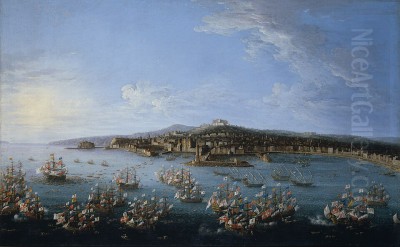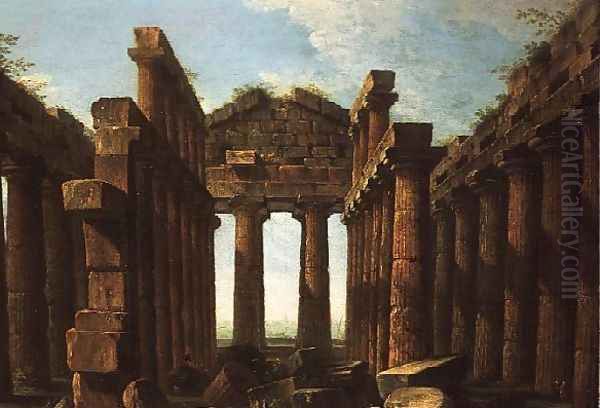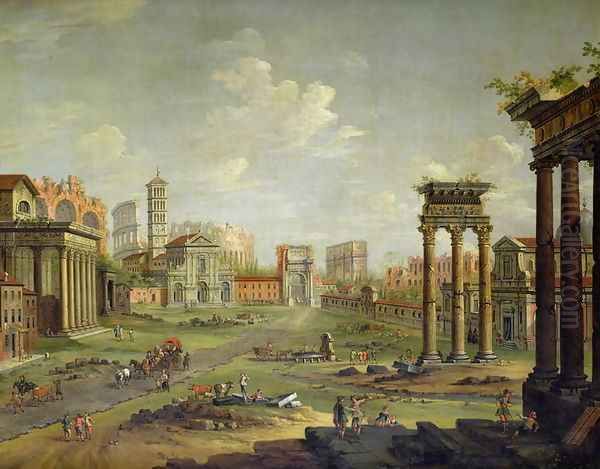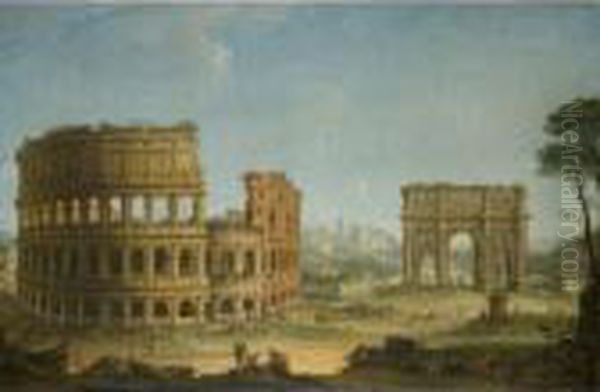Introduction: An Itinerant Master of Views

Antonio Joli, born in Modena, Italy, around 1700 and passing away in Naples in 1777, stands as a significant figure in the landscape of 18th-century European art. He was a highly skilled and prolific Italian painter, best known for his mastery of the veduta (view painting) and the capriccio (architectural fantasy). Beyond his easel paintings, Joli also enjoyed a successful parallel career as a talented stage designer (scenografo), bringing his keen sense of perspective and architectural understanding to the theatre. His life was marked by extensive travel and prestigious appointments, working across major European centres like Rome, Venice, London, Madrid, and Naples, leaving behind a rich legacy of works that capture the grandeur of cities, the allure of ancient ruins, and the vibrancy of ceremonial life.
Joli's art catered significantly to the tastes of Grand Tourists – the wealthy, often British, travellers undertaking educational journeys through Europe. His detailed and often topographically accurate views served as sophisticated souvenirs, while his imaginative capricci offered romanticized visions of antiquity blended with contemporary life. He navigated the artistic currents of his time, absorbing influences from the late Baroque and contributing to the developing Neoclassical sensibility, particularly in his depictions of archaeological sites. His ability to combine meticulous detail with atmospheric effects and a sense of theatricality made him one of the most sought-after view painters of his generation.
Early Life and Artistic Formation in Modena and Rome
Antonio Joli's artistic journey began in his birthplace, Modena. While details of his earliest training are somewhat sparse, it is known that he received foundational instruction in painting there. Some sources suggest early contact with artists like Raffaelino da Modena or influence from the Galli da Bibiena family, renowned specialists in theatrical design and perspective painting, which perhaps laid the groundwork for his later success in stagecraft. The artistic environment of Modena, though not a primary centre like Rome or Venice, provided him with the initial skills necessary to pursue a more ambitious career.

The pivotal moment in Joli's early development came around 1720 when he moved to Rome. This city, the epicentre of classical antiquity and a hub for artists from across Europe, offered unparalleled opportunities for learning and advancement. Joli entered the bustling studio of Giovanni Paolo Panini (c. 1691–1765), who was already a leading figure in Roman view painting, celebrated for his depictions of the city's ancient monuments and contemporary festivities. Working under Panini was crucial; Joli honed his skills in perspective, architectural rendering, and the arrangement of small figures (staffage) that animate such scenes. He is known to have produced copies of Panini's popular works, a common practice for apprentices learning the master's style and techniques.
During his time in Rome, Joli also absorbed influences from other prominent artists. He is believed to have studied or been significantly influenced by Gaspar van Wittel (1653–1736), known in Italy as Gaspare Vanvitelli. Van Wittel, a Dutch painter who settled in Rome, was a foundational figure in the development of Italian veduta painting, known for his clear light and precise topographical depictions. Exposure to Van Wittel's work likely reinforced Joli's commitment to accuracy and detail. Furthermore, the legacy of earlier architectural painters like Viviano Codazzi (1604–1670), whose dramatic compositions featuring ruins and perspective were influential, likely filtered through the Roman artistic milieu and Panini's own practice, contributing to Joli's sense of spatial depth and theatricality.
Developing the Veduta: Rome and Venice
Joli's years in Rome were formative, establishing his reputation as a capable painter of cityscapes and architectural views. He moved beyond mere apprenticeship, developing his own variations on the themes popularized by Panini. His Roman vedute often depicted famous landmarks, squares, and festivals, capturing the dynamic life of the city alongside its monumental past. He also began collaborating with theatre designers, possibly leveraging connections made through the Galli da Bibiena family or through his master Panini, who also occasionally designed festival decorations. This early involvement in stage design would become a consistent thread throughout his career.
After establishing himself in Rome, Joli sought opportunities elsewhere. He spent time in Venice, another major centre for view painting, particularly during the mid-18th century. Venice was the city of Canaletto (Giovanni Antonio Canal, 1697–1768), arguably the most famous vedutista of all time, as well as Francesco Guardi (1712–1793) and Canaletto's nephew, Bernardo Bellotto (1721–1780). While in Venice, Joli continued to paint city views and likely engaged with the local artistic scene. In 1754, his standing was formally recognized when he became a member of the prestigious Venetian Academy of Fine Arts (Accademia di Belle Arti di Venezia). This appointment also came with the responsibility of serving as a conservator for public painting and sculpture, indicating a respected position within the Venetian art establishment.

His Venetian works, while perhaps less numerous than those from Rome or Naples, show his adaptation to the unique light and atmosphere of the lagoon city. He painted views of its canals, palaces, and ceremonial events, competing in a market dominated by local masters. His style, while distinct, shared the era's fascination with detailed representation and the capturing of specific moments in urban life, whether everyday scenes or grand public spectacles. His experience in Venice further broadened his artistic vocabulary and his network of patrons.
International Exposure: London and Madrid
Joli's ambition and the demand for his work led him further afield. He spent a significant period in London, likely arriving around the mid-1740s and staying for several years. London during this time was a burgeoning metropolis and a key destination for continental artists seeking patronage, particularly from the British aristocracy deeply engaged in the Grand Tour. Joli found considerable success there, producing views of the River Thames, landmarks like Westminster Abbey and St. Paul's Cathedral, and depictions of the city's expanding vistas. His series of paintings, such as the celebrated Four Views of London, became highly sought after and represent some of his most accomplished work outside Italy. One of these London views achieved a record auction price for the artist centuries later.
While in London, Joli also actively pursued his career as a stage designer. He worked for the King's Theatre at Haymarket, a major venue for Italian opera, designing sets that showcased his expertise in perspective and architectural illusion. This dual practice as both easel painter and scenographer was not uncommon, but Joli excelled in both fields, leveraging his skills across different mediums. His London period solidified his reputation internationally and connected him with influential British patrons who would continue to commission works from him even after his return to Italy.
Following his time in London, Joli also worked in Madrid. Spain, under the Bourbon monarchy, maintained close ties with Italy, particularly Naples (which was ruled by a Spanish Bourbon). King Charles III of Spain (who had previously been King Charles VII of Naples) was a significant patron of the arts. Joli's presence in Madrid, likely around the early 1750s before settling definitively in Naples, allowed him to work for the Spanish court and aristocracy. While fewer details are known about his specific commissions in Madrid compared to London or Naples, this period further underscores his international reach and the high demand for his particular brand of view painting and decorative skill across Europe.
Court Painter in Naples: The Final Flourishing

The latter part of Antonio Joli's career was primarily spent in Naples, where he settled around 1761 or 1762 and remained until his death in 1777. Naples, under the rule of the Bourbon Kings Charles VII (later Charles III of Spain) and his son Ferdinand IV, was a vibrant cultural capital and a major stop on the Grand Tour. The city's dramatic setting, dominated by Mount Vesuvius and the Bay of Naples, along with the nearby newly excavated archaeological sites of Pompeii and Herculaneum, provided rich subject matter for artists.
Joli achieved a prestigious position in Naples, being appointed Pittore della Corte Reale (Painter to the Royal Court) for King Ferdinand IV. This role involved creating paintings for the royal palaces, documenting court events, and potentially contributing to decorative schemes. He produced numerous large-scale vedute of Naples, capturing panoramic views of the city and its bay from various vantage points. These works are characterized by their expansive scope, meticulous detail in depicting buildings and ships, and the lively inclusion of figures representing the city's diverse population. Examples like Naples: From the River Looking North-West showcase this grand manner.
Beyond Naples itself, Joli was among the earliest artists to systematically depict the recently rediscovered Greek temples at Paestum, south of Naples. His paintings of these majestic Doric structures, such as Paestum: The Temple of Neptune, often presented with a slightly romanticized atmosphere, were highly influential and catered perfectly to the burgeoning Neoclassical interest in authentic Greek architecture. He also continued to paint dramatic scenes of Mount Vesuvius, sometimes depicting its eruptions, a subject of perennial fascination for visitors. His Neapolitan period saw collaborations with court architects like Francesco Valenti on designs for ephemeral decorations for festivals and public celebrations, linking back to his stage design expertise. Contemporaries active in Naples whose work sometimes intersected thematically included Pietro Fabris, known for scenes of Neapolitan life and Vesuvius, and Jacques Volaire, another painter specializing in dramatic landscapes and volcanic eruptions. Jacob Philipp Hackert, though arriving slightly later, would continue the tradition of detailed Neapolitan landscape painting for the court.
Artistic Style: Vedute, Capricci, and Theatricality

Antonio Joli's artistic style is primarily defined by his work in two related genres: the veduta and the capriccio. His vedute aimed for topographical accuracy, capturing recognizable locations with considerable detail. He employed a strong sense of linear perspective, often using a high viewpoint to encompass broad panoramas of cities like Rome, London, or Naples. His rendering of architecture was precise, demonstrating a solid understanding of structure and form. Unlike the sometimes crystalline, sun-drenched clarity of Canaletto, Joli's lighting could be softer, more atmospheric, particularly in his Neapolitan works, perhaps reflecting the southern Italian climate. His paintings are typically populated with numerous small figures (staffage), carefully placed to add life, scale, and narrative interest to the scenes. These figures often represent various social classes engaged in everyday activities or participating in specific events, adding a documentary quality to his views.
Alongside his realistic views, Joli excelled at the capriccio. This genre involved the creation of imaginary landscapes or architectural scenes, often combining real monuments with fictional settings or juxtaposing ruins from different places and periods. His capricci, like those of his master Panini or the slightly later French artist Hubert Robert (1733–1808), often featured classical ruins, evoking a sense of nostalgia for antiquity mixed with picturesque decay. Works like his Perspective View of the Ancient Roman Baths or imagined scenes incorporating Roman landmarks demonstrate his ability to manipulate architectural elements for dramatic and poetic effect. These paintings allowed for greater imaginative freedom than the strict veduta.
A defining characteristic across Joli's work, whether veduta, capriccio, or stage design, is a palpable sense of theatricality. This likely stemmed from his parallel career as a scenographer and his training within traditions influenced by the Galli da Bibiena family. His compositions often feel like carefully constructed stage sets, with strong diagonals leading the eye into the space, dramatic contrasts of light and shadow, and a framing of the central view. Even his topographically accurate vedute possess a certain grandeur and compositional formality that borders on the theatrical, elevating the mundane reality into a more imposing spectacle. This blend of accuracy, imagination, and stagecraft defines his unique contribution to 18th-century painting.
The Scenographer: Joli and the Theatre
Antonio Joli's career as a stage designer (scenografo) ran parallel to his work as an easel painter and was a significant aspect of his artistic identity. His training, potentially influenced early on by the Galli da Bibiena dynasty – the preeminent family of Baroque theatre designers known for their elaborate perspective scenes (scena per angolo) – equipped him with the specialized skills needed for the stage. He applied his mastery of perspective, architectural rendering, and dramatic composition to create immersive and illusionistic settings for opera and theatre productions.
His work in scenography is documented in several major European cities. In Rome, he collaborated on theatrical projects early in his career. His time in Venice, a major centre for opera, undoubtedly involved work for its famous theatres. His most documented stage design work comes from his period in London, where he was employed at the King's Theatre in Haymarket, the primary venue for Italian opera seria. Designing for opera required creating multiple sets for various acts, often depicting palaces, gardens, temples, or exotic locales, all rendered with convincing depth and grandeur on the stage.
Later, in Naples, his skills were likely employed for court entertainments and possibly public theatres, although his role as court painter might have taken precedence. His involvement in designing ephemeral architecture and decorations for royal festivals and processions in Naples, alongside architects like Francesco Valenti, was a direct extension of his scenographic talents. These temporary structures, built for specific occasions like royal entries or religious celebrations, required the same understanding of perspective, scale, and dramatic effect as theatre sets. Joli's ability to work across easel painting, stage design, and festival decoration highlights the interconnectedness of these arts in the 18th century and his versatility as an artist.
Masterpieces and Representative Works
Antonio Joli's extensive oeuvre includes numerous paintings that are considered highlights of his career and representative of his style. Several works stand out for their quality, subject matter, or historical significance:
Four Views of London: This series, likely painted during his time in England in the 1740s, captures panoramic vistas of the city and the Thames. Known for their detail and atmospheric quality, they are among his most celebrated works and highly valued, with one setting an auction record for the artist. They provide invaluable visual documentation of mid-18th century London.
Naples: From the Posillipo Shore (and similar Neapolitan Views): Joli produced many large, detailed panoramas of Naples and its bay, often commissioned by the court or Grand Tourists. These works capture the city's unique topography, bustling harbour, and the ever-present Vesuvius, showcasing his skill in rendering complex cityscapes with accuracy and vibrancy.
Paestum: The Temple of Neptune (and other Paestum views): Joli was one of the first painters to depict the Greek temples at Paestum extensively. These works, combining archaeological interest with a picturesque sensibility, were crucial in disseminating images of these important ruins throughout Europe and contributed to the rise of Neoclassicism.
The Flooding of Piazza Navona in Rome: Recalling a subject also treated by his master Panini, this painting depicts a specific Roman event – the summer practice of flooding the Piazza Navona for festivities. It showcases Joli's ability to handle complex compositions with numerous figures and architectural elements within a specific historical context.
Campo Vaccino, Rome: Depicting the Roman Forum, then known as the 'Campo Vaccino' (Cow Field), this work is a classic example of the veduta focused on ancient ruins within the contemporary city. It combines archaeological interest with scenes of daily life, a hallmark of Roman view painting in the tradition of Panini.
Capriccio of Roman Ruins (various examples): Joli painted numerous architectural fantasies featuring arrangements of classical ruins, arches, columns, and sculptures, often set in idealized landscapes. These capricci allowed him to display his inventiveness and mastery of perspective while evoking a romanticized vision of antiquity.
The Visit of the French Ambassador Chevalier de Chaumont to the King of Siam in 1685: This historical painting, depicting an event from the previous century, showcases Joli's ability to handle complex historical subjects with elaborate detail, particularly in rendering exotic settings and ceremonial grandeur. Its high auction price reflects its unique subject matter and quality.
These examples illustrate the range of Joli's work, from topographically precise cityscapes and landscapes to imaginative architectural fantasies and historical scenes, all executed with technical skill and a distinct artistic vision.
Contemporaries and Artistic Context
Antonio Joli operated within a rich and dynamic European art world, interacting with, influenced by, and competing against numerous other talented artists. Understanding his contemporaries helps place his achievements in context:
Giovanni Paolo Panini (c. 1691–1765): Joli's master in Rome, Panini was the leading painter of Roman views and capricci before Joli's own rise. His influence on Joli's style, particularly in composition and the depiction of ruins and festivals, is undeniable.
Gaspar van Wittel (Gaspare Vanvitelli) (1653–1736): A foundational figure for Italian vedutismo, Van Wittel's precise topographical style likely influenced Joli's approach to accuracy in his cityscapes.
Canaletto (Giovanni Antonio Canal) (1697–1768): The most famous Venetian vedutista, known for his luminous views of Venice and later London. Joli worked in the same cities and genre, though his style often differed in atmosphere and handling.
Bernardo Bellotto (1721–1780): Canaletto's nephew, who developed a distinct, often cooler and more sharply detailed style of veduta, working extensively in Dresden, Vienna, and Warsaw.
Francesco Guardi (1712–1793): Another major Venetian painter, whose vedute and capricci became increasingly atmospheric and free in brushwork later in his career, contrasting with Joli's generally tighter handling.
Giovanni Battista Piranesi (1720–1778): Primarily an etcher, Piranesi's dramatic and often exaggerated views of Roman antiquities (Vedute di Roma) and his imaginary prisons (Carceri d'invenzione) explored similar themes of architectural grandeur and fantasy, albeit in a different medium and with a darker sensibility.
Hubert Robert (1733–1808): A French painter who spent considerable time in Rome, Robert specialized in picturesque paintings of ruins and capricci, often compared to Panini and Piranesi, and contemporary to Joli's later career.
Claude-Joseph Vernet (1714–1789): A prominent French landscape and marine painter who worked in Rome for two decades. His dramatic seascapes and landscapes, often featuring specific locations, shared the era's interest in topographical views combined with atmospheric effects.
Pietro Fabris (active 1740–1792): Active in Naples during Joli's time there, Fabris documented Neapolitan life, costumes, and notably the volcanic activity of Vesuvius, often catering to the Grand Tour market.
Jacques Volaire (1729–c.1802): A French painter who settled in Naples, famous for his dramatic nocturnal scenes of Vesuvius erupting, a subject Joli also painted.
The Galli da Bibiena Family: This dynasty of theatre designers (e.g., Ferdinando, Francesco, Giuseppe) dominated European stage design in the late Baroque and early Rococo periods. Their complex perspective techniques influenced Joli's own scenography.
Viviano Codazzi (1604–1670): Though earlier, Codazzi's pioneering work in architectural painting and ruins influenced the development of the genre inherited by Panini and Joli.
Joli navigated this landscape successfully, carving out his niche through extensive travel, court appointments, and a versatile practice that spanned detailed vedute, imaginative capricci, and practical stage design, all highly valued by the cosmopolitan elite of the 18th century.
Legacy, Market Value, and Conclusion
Antonio Joli left a significant mark on 18th-century European art. His legacy lies primarily in his contribution to the veduta and capriccio genres. He expertly catered to the demands of the Grand Tour market, producing works that were both accurate records of place and evocative artistic statements. His paintings provide invaluable visual documentation of cities like London, Rome, and Naples during a period of significant change and development. His depictions of Paestum were particularly influential in popularizing these important Greek ruins. Furthermore, his parallel career as a scenographer highlights the fluidity between fine art and theatrical design in the Baroque and Rococo periods.
Anecdotally, a glimpse into his personal circumstances after his death is provided by the record of his wife, Anna, petitioning King Ferdinand IV for financial assistance due to hardship, suggesting that despite a successful career with royal patronage, financial security was not guaranteed. This perhaps reflects the precarious nature of artistic careers, even for established figures.
In the contemporary art market, Antonio Joli's works are highly regarded and regularly appear at major auction houses like Christie's and Sotheby's. His paintings command significant prices, ranging from tens of thousands into the millions of dollars or pounds, depending on the size, quality, subject matter, provenance, and condition of the work. His views of London, Naples, and Paestum are particularly sought after. The record price achieved for his Four Views of London (£1.44 million) underscores the high value placed on his best work, especially pieces connected to the British Grand Tour. Works like the View of Vesuvius overlooking Naples (€605,600) and the historical scene The Visit of the Ambassador to the King of Siam ($693,000) further demonstrate the strong market demand. His appeal lies in the combination of historical interest, decorative quality, technical skill, and the enduring fascination with the cities and sites he depicted.
In conclusion, Antonio Joli was a versatile, skilled, and widely travelled artist who excelled as both a painter of views and architectural fantasies and a designer for the stage. From his training in Modena and Rome under masters like Panini, through his international successes in Venice, London, and Madrid, to his final flourishing as a court painter in Naples, Joli consistently produced works of high quality that captured the spirit of his age. He skillfully blended topographical accuracy with atmospheric effect and theatrical composition, creating a distinctive style that appealed to royalty, aristocracy, and Grand Tourists alike. His paintings remain important documents of 18th-century Europe and testaments to his enduring artistic talent.